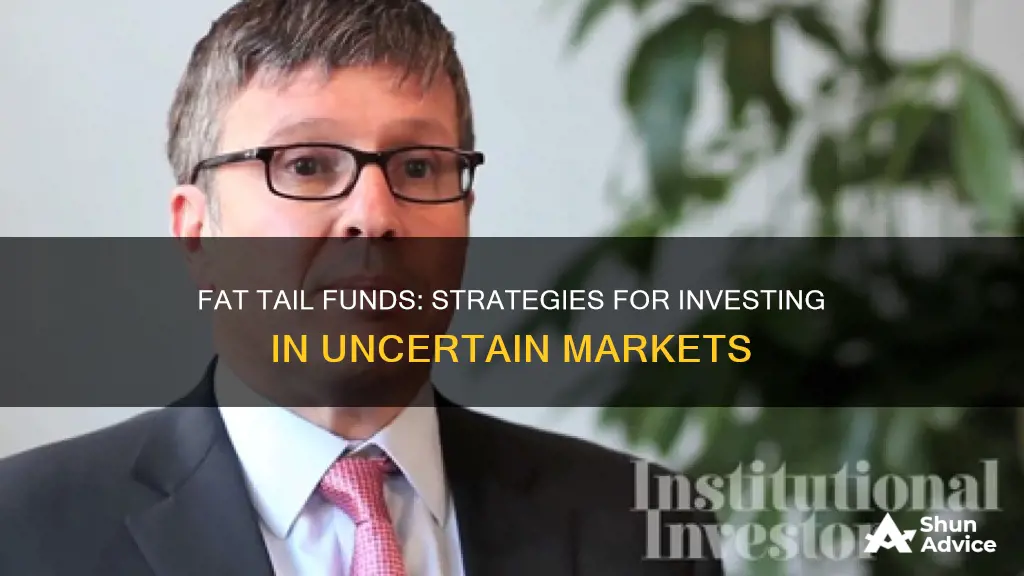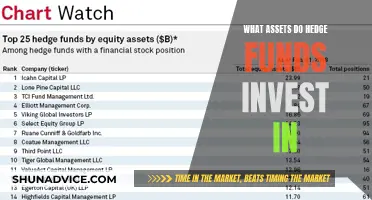
Fat tail funds are investment strategies designed to protect investors from extreme market events and longer-term trends. They are called fat tail funds because they focus on the extreme ends of a normal distribution curve, which are usually unlikely to occur but can have extreme disruptive consequences. These events can present great risks and opportunities for investors. Investing in fat tail funds involves anticipating these events and finding ways to invest around them. It is important to note that fat tail funds are not mainstream and involve taking bets on unlikely occurrences. Investors interested in fat tail funds can explore alternative investment research and advisory businesses that specialize in this area.
| Characteristics | Values |
|---|---|
| Definition | Tail risk is the chance of a large investment gain or loss due to a rare event. |
| Classical Definition | The possibility that an investment will move more than three standard deviations from the mean is greater than what is shown by a normal distribution. |
| Tail Risk Protection | Put options, which give investors the right to sell a security in the future. |
| Tail Hedge Fund Approach | Managing exposure at the asset class level, using derivatives among various asset classes such as rates, foreign exchange, credit, and commodities. |
| Tail Risk Strategy | Rotating positions in the portfolio based on the prospects of different managers. |
| Fat Tail Events | Unlikely and unexpected occurrences with extreme disruptive consequences. |
What You'll Learn

Understanding tail risk
Tail risk, sometimes called "fat tail risk", is a form of portfolio risk. It occurs when there is a chance that an investment will move more than three standard deviations from the mean, which is greater than what is shown by a normal distribution.
When a portfolio of investments is put together, it is assumed that the distribution of returns will follow a normal distribution. Under this assumption, the probability that returns will move between the mean and three standard deviations, either positive or negative, is approximately 99.7%. This means that the probability of returns moving more than three standard deviations beyond the mean is 0.3%.
However, the concept of tail risk suggests that the distribution is not normal, but skewed, and has fatter tails. The fatter tails increase the probability that an investment will move beyond three standard deviations. This happens when a rare, unpredictable, and very important event occurs, resulting in significant fluctuations in the value of the stock.
These tail events are often referred to as black swan events and they can produce disastrous effects on the returns of the portfolio in a very short span of time. Fat tails suggest that the likelihood of such events is in fact greater than the one predicted by traditional strategies, which subsequently tend to understate volatility and risk of the asset.
The importance of considering tail risk in portfolio management is not just theoretical. From the late 1980s to the early 2010s, there were at least seven episodes that can be viewed as tail events: the 1987 equity market crash, the 1994 bond market crisis, the 1997 Asian financial crisis, the 1998 Russian financial crisis and the Long-Term Capital Management blow-up, the dot-com bubble collapse, the subprime mortgage crisis, and the infamous Bankruptcy of Lehman Brothers.
Although tail risk cannot be eliminated, its impact can be somewhat mitigated by robust diversification across assets, strategies, and the use of an asymmetric hedge.
Balanced Funds: Diversified, Stable, and Smart Investment Strategy
You may want to see also

The impact of tail events
Tail events, also known as black swan events, can have a disastrous effect on portfolio returns in a very short space of time. These events are rare and unpredictable, but they do occur more often than many investors think, and they can have a large impact on market returns.
The occurrence of tail events can result in significant fluctuations in the value of stocks, leading to substantial losses for investors. For example, during the 2007-2008 financial crisis and the Great Recession, even highly sophisticated institutions, such as university endowments and sovereign wealth funds, experienced large double-digit percentage drops in value. Similarly, during the global financial crisis in 2008, multi-asset class portfolios suffered losses ranging from 20% to 30% in just a few months.
The common technique of assuming a normal distribution of price changes underestimates the impact of tail events, leading to an underestimation of asset prices, stock returns, and the subsequent risk management strategies. This is because traditional portfolio strategies assume that market returns follow a normal distribution, or a bell curve, which is not always the case. In reality, the distribution of returns is often skewed, with fatter tails, indicating a higher probability of extreme events occurring.
To mitigate the impact of tail events, investors can adopt strategies such as diversifying their portfolios, using different hedging positions, and actively managing their investments. By doing so, investors can enhance their returns over the long term and protect their portfolios from significant losses.
In summary, tail events are rare but impactful occurrences that can have a significant negative effect on investment portfolios. They highlight the importance of considering tail risk in portfolio management and the need for robust diversification and hedging strategies to minimise potential losses.
Unlocking Private Equity: The Power of Fund of Funds
You may want to see also

Strategies for hedging against tail risk
Tail risk is the chance of a loss occurring due to a rare event, such as the 9/11 attacks, the Japanese tsunami, or the 2008 financial crisis. These events are hard to predict and can have catastrophic consequences for investment portfolios. Therefore, investors should consider implementing strategies to hedge against tail risk. While these strategies may enhance returns over the long term, investors must assume short-term costs. Here are some strategies to consider:
Diversification: Investors can diversify their portfolios by investing in a range of asset classes, such as foreign real estate, bonds, commodities, and equities. This reduces the impact of any single event on the overall portfolio.
Put options: Purchasing put options on a broad market index, such as the S&P 500, is a common way to hedge against tail risk. Put options give investors the right to sell a security at a specified price, limiting potential losses.
Cash and bonds: Holding cash and bonds can be an effective hedge against tail risk. While these assets may not provide high returns in the long term due to inflation, they can be valuable during market downturns when other asset classes lose value.
Tail risk ETFs: Exchange-traded funds (ETFs) specifically designed to mitigate tail risk, such as Cambria's TAIL ETF, can be used to hedge against potential losses. These ETFs typically invest in a combination of put options and intermediate-term government bonds.
Trend-following strategies: Trend-following strategies, such as investing in commodities or using trend-following funds, can help to offset potential losses from tail events. Commodities often provide good returns when stocks and bonds are weak, and trend-following funds can capitalise on market trends.
Risk management: Tail risk should be considered a form of risk management rather than a stand-alone strategy. Investors should assess their risk tolerance and consider the potential impact of tail events on their portfolios. This may involve seeking out specialised tail risk funds or strategies offered by hedge funds.
It's important to note that hedging against tail risk can be challenging and may involve sacrificing some returns. Additionally, the effectiveness of these strategies may vary depending on the specific circumstances and investor preferences.
Best ELSS Funds to Invest in India: Smart Picks
You may want to see also

How to structure a portfolio to mitigate tail risk
Tail risk, or fat tail risk, refers to the financial risk of an asset or portfolio of assets moving more than three standard deviations from its current price, above the risk of a normal distribution. Tail risk is the chance of a loss occurring due to a rare event, such as a market crash or sudden price drop, and can have a significant impact on investment portfolios.
Diversification
Diversification across assets and strategies is a crucial way to reduce tail risk. By spreading investments across various asset classes, industries, and geographic locations, the impact of any single event is lessened. This approach helps to ensure that a portfolio is not overly exposed to any one particular area, thus reducing the likelihood of extreme losses.
Asymmetric Hedge
Using an asymmetric hedge can also help to mitigate tail risk. This involves holding a combination of long and short positions, with the short positions acting as a hedge against potential losses on the long positions. The key is to structure the portfolio so that potential gains outweigh potential losses, creating an asymmetric payoff structure.
Active Tail Risk Management
Active tail risk managers play a vital role in devising effective hedging strategies. They identify potential tail events and their repercussions, construct the hedge, and actively manage positions and risk levels to maintain optimal protection. This approach helps generate alpha and minimise 'negative carry', providing ongoing security and convex payoffs during tail events.
Minimum-Volatility Strategies
Minimum-volatility strategies have proven effective in managing tail risk. These strategies aim to reduce portfolio volatility by investing in less risky assets or using derivatives to hedge against potential losses. This approach can be cost-effective and simple to implement, as it does not require frequent rebalancing.
Tail Risk Protection Funds
Some institutional investors are turning to dedicated tail risk protection funds. For example, AXA Investment Managers offers a series of funds of hedge funds that aim to protect investors from shock market events. These funds are designed to provide inversely correlated returns to equities and equity-related assets during times of high stress.
By employing these strategies, investors can structure their portfolios to better withstand the impact of tail events, thus mitigating tail risk and enhancing long-term returns.
Mutual Funds: Why They Beat Direct Investing
You may want to see also

Alternative investment options for reducing tail risk exposure
Tail risk is a form of portfolio risk that arises when an investment moves more than three standard deviations from the mean, which is greater than what is shown by a normal distribution. Tail risk events are rare but can have dramatic implications for investors.
Diversification:
Diversifying your portfolio across different asset classes, such as equities, currencies, bonds, and commodities, can help reduce overall tail risk. This is because different asset classes tend to have a low correlation with each other, meaning they don't move in the same direction all the time.
Hedging:
Hedging strategies aim to protect against potential losses by taking offsetting positions. For example, investors can purchase derivatives such as put options or use more complex strategies like credit default swaps (CDS) or volatility products like the Cboe Volatility Index (VIX). These strategies can be effective in reducing downside risk during market stress.
Managed Futures Funds:
These funds buy long and short futures contracts in equity indexes. They can be a good option for investors looking to reduce exposure to tail risks as they can perform well during market crises.
Short-Bias Funds:
Short-bias funds maintain a constant short net market exposure, aiming to provide positive returns in declining markets. They identify overvalued companies or those experiencing negative events that will cause their market prices to decline.
Treasury Inflation-Protected Securities (TIPS):
TIPS are US government-issued debt instruments that protect against inflation. The principal value of TIPS increases with inflation and decreases with deflation, ensuring that the interest payments received by investors rise and fall with inflation.
High-Yield Loans:
High-yield loans, or bank debt, are senior, floating-rate corporate loans issued by below-investment-grade companies. They have a unique combination of seniority, security, and covenants, which helps maintain high recovery rates in the event of default.
Direct Lending:
Direct lending involves providing secured loans to companies, which can be a good alternative to publicly traded fixed-rate debt instruments that are vulnerable to rising interest rates.
Commodities:
Commodities such as gold and oil can serve as a hedge against inflation and market turmoil. They tend to rise in value during unexpected inflationary periods and are considered safe havens by many investors.
Remember, when considering these alternative investment options, it's important to analyse your specific portfolio risk and return factors. Each strategy has its advantages and disadvantages, and the suitability of each will depend on your investment goals, risk tolerance, and time horizon.
A Simple Guide to Tracker Fund Investment
You may want to see also
Frequently asked questions
Fat tail funds are investment funds that aim to protect investors from extreme market events and longer-term trends. They are designed to provide strong inversely correlated returns to equities and equity-related assets during periods of high stress or volatility.
Fat tail funds, also known as tail risk funds, aim to provide returns that are de-correlated from the broader market. They focus on low volatility strategies and use derivatives to manage exposure across various asset classes such as rates, foreign exchange, credit, and commodities.
Fat tail funds offer investors protection from negative tail events, which are rare but can have a significant impact on portfolios. By investing in these funds, individuals can hedge against the risk of large investment losses due to sudden and unforeseen events. Additionally, fat tail events present unique investment opportunities that can lead to significant gains.







